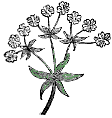
Introduction
The Patten Collection of Herbals and Early Gardening Books
According to the Oxford English Dictionary, the term herbal, not used until 1516, denotes a "book containing names and descriptions of herbs or of plants in general, with their properties and virtues." Herbals can be appreciated not only for their botanical information, but also for the outstanding graphic artistry that enhances them, for the many styles of expression, and for interesting turns of phrase.
Writers of early herbals were more concerned with curing illnesses than describing plants, and thus these early publications included remedies not only from the plant world, but also from the animal and mineral kingdoms. It is important to remember that many of these herbals pre-date the current Linnean botanical classification scheme, which complicates any comparison with modern plants.
Doris and Marc Patten, photographed at home in their Montana ranch house, collected these landmark herbals and early gardening works which date from the 15th century.

Doris and Marc Patten
The Pattens gathered together these many treasures at their ranch in the Montana "Big Sky" country. Thanks to their children Duncan, Joan, and Jonathan, the books will continue to be treasured and shared with scholars in Hayden Library's Special Collections.

The Pattens' Montana ranch house
The presentation of this catalog affords each viewer an opportunity to delight in the beauty of these early works and to revere the richness of this grand collection.
Duncan Patten discusses the Patten family legacy.
Credit for this catalog must be given to Chris Purpus who typed and proofread the text; to Diane Rhodes and Chris Purpus for supplying textual annotations; to Anna Quan Leon for assisting in scanning images; and to Gold Canyon Multimedia for the design and development of the program.
This project has been made possible by a grant from the Richard and Marilyn Wurzburger Trust.
Land acknowledgement
The ASU Library acknowledges the twenty-three Native Nations that have inhabited this land for centuries. Arizona State University's four campuses are located in the Salt River Valley on ancestral territories of Indigenous peoples, including the Akimel O’odham (Pima) and Pee Posh (Maricopa) Indian Communities, whose care and keeping of these lands allows us to be here today. ASU Library acknowledges the sovereignty of these nations and seeks to foster an environment of success and possibility for Native American students and patrons. We are advocates for the incorporation of Indigenous knowledge systems and research methodologies within contemporary library practice. ASU Library welcomes members of the Akimel O’odham and Pee Posh, and all Native nations to the Library.

